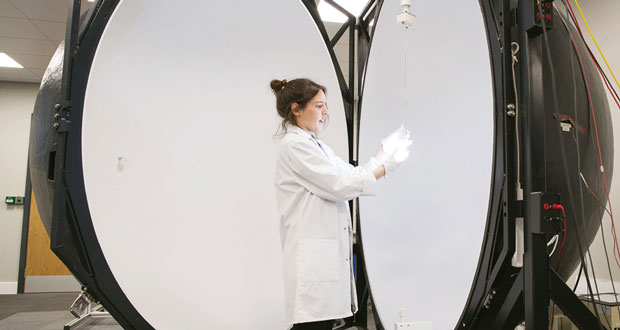 Jack Adams, Laboratory Manager at the LIA, shares how the LIA Laboratory testing is there to support facilities managers to help meet lighting safety requirements and prevent disasters from occurring
Jack Adams, Laboratory Manager at the LIA, shares how the LIA Laboratory testing is there to support facilities managers to help meet lighting safety requirements and prevent disasters from occurring
In lighting safety, the Part B approved guidance document of the Building Regulations concerns lighting and the spread of flame. TP (thermoplastic) materials, such as polycarbonate (PC), acrylic (PMMA) and polystyrene (PS), are commonly used as diffusers in light fittings. When a lighting diffuser is deemed to be part of a ceiling it must be made of either TP(a) or TP(b) rated material.
The testing procedure requires that the material self-extinguishes, and any flaming and afterglow must not exceed five seconds once the source of flame is removed. In the building regulations, a TP(a) product used in a lighting design will comply, subject to a few restrictions, and if a TP(b) product is used, which it can still comply, there are more restrictions for the spacing of these diffusers.
The Lighting Industry Association (LIA) Laboratory is a state-of-the-art facility that provides testing and certification services for lighting products. It offers a full range of flammability tests, including, TP(a)/TP(b) testing, glow wire flammability and needle flame testing. Testing to the standards covering these tests is within the laboratory’s UKAS scope of accreditation (1286).
However, the LIA believes the test methods currently used to determine TP() classification have not kept up with current luminaire design practices, especially since the widespread use of LED technology.
CLASSIFYING LIGHTING MATERIALS
In order to classify materials as either TP(a) or TP(b) a BS 2782-0:2004 method 508A: Rate of burning laboratory method is used. In the 2011 version of the standard method 508A, it clearly states that: “The method has been declared obsolescent but is made available here because it is referred to in the Approved Document B Building Regulations.” Method 508A was originally defined within BS 2782-5:1970 and was withdrawn by BSI in 1992. Therefore, the building regulations are using a test method no longer considered as best practice to classify thermoplastic materials.
CHANGES TO LIGHT SOURCES
When Method 508A was developed, light sources generally used single piece prismatic controllers or opal diffusers. However current methods of optical control are usually via a sandwich of materials with dissimilar burning properties and varying thicknesses.
Method 508A as generally interpreted is not suitable for testing this type of composite construction. The Building Regulations only consider the lower face of the luminaire, the part of the thermoplastic that faces directly into a room or space. When this face was a part of a single piece optic, or at least of a sturdy and relatively thicker construction, this was not particularly unreasonable. In modern optics the lower thermoplastic layer may be quite thin in cross-section, and therefore significantly different from the sample used in testing, and the other materials used in the optical sandwich may have little resistance to the spread of flame.
This means that the safety of the space relies upon the full diffuser behaving the same as the lower thermoplastic material under conditions of fire, staying undamaged, and remaining so through life.
The legal requirements of the building regulations are to initially resist the spread of flame and once a flame is established limit the growth of the fire. While testing only the bottom material will give some indication of the initial resistance to ignition, once ignition has occurred and a flame is established it will no longer give any reliable indication on how the flame will grow and spread.
SAFETY TESTING
We need to consider why we use a test method that has been declared obsolete and why do we use this method to test a sample that is completely unrepresentative of the optical construction in use?
For the first part of the question a relatively easy solution can be proposed.
BS EN 60695-11-10, fire hazard testing – Test flames. 50 W horizontal and vertical flame test methods, has similarities to the Method 508A and could be reasonably applied. This would move from an obsolete to a current test method. It would also allow expected mounting orientation to be considered as it may test a material in both horizontal (e.g. ceiling mounted) and vertical (e.g. wall mounted) orientation.
However, this would not solve the issue of the test method being for the testing of single materials, not for optical sandwiches consisting of a number of layers of differing materials. The test method would need to be amended to overcome this, and if necessary redefined within building regulations.
So, when a product is assessed to be TP(a) or TP(b), the question a customer should ask is ‘how was this test performed and is it representative of the actual product being purchased and installed?’ Declaring a TP() rating based purely on testing an unrepresentative sample of the bottom layer of the optics should not be considered acceptable.
The LIA is strongly of the opinion that to meet the legal requirement of the building regulations, modern composite diffusers need to have their TP() rating based upon testing of the complete sandwich of materials as used within the recessed luminaire. This allows FMs to demonstrate a complete level of legal compliance to the national requirements.To view the LIA Laboratory decision on this please visit: https://bit.ly/3ZkLRR8





